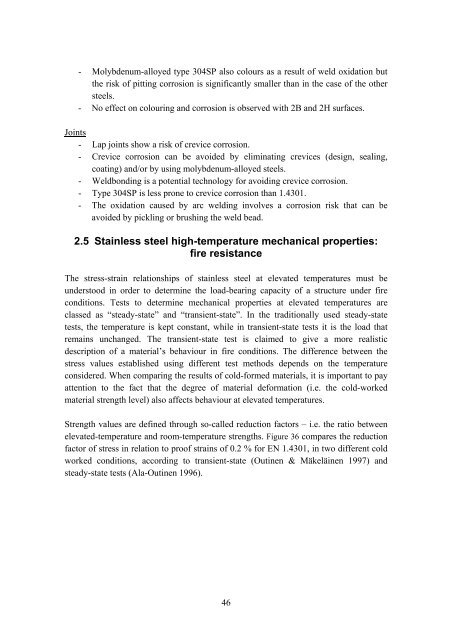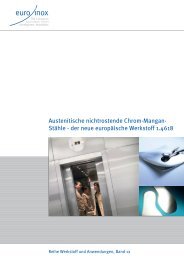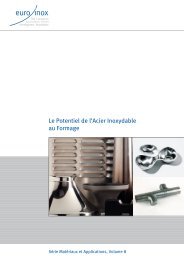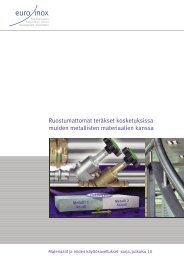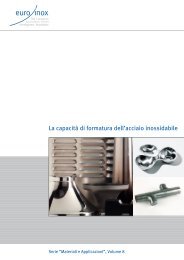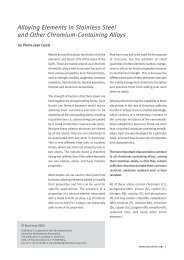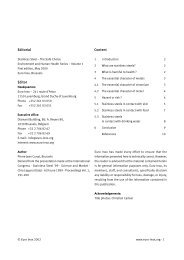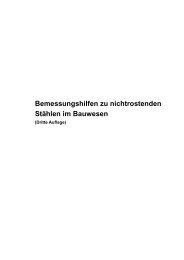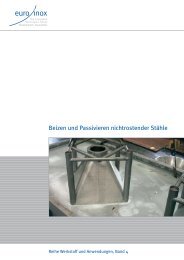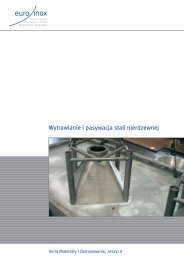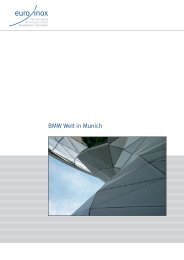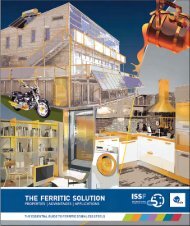Innovative Stainless Steel Applications in transport ... - Euro Inox
Innovative Stainless Steel Applications in transport ... - Euro Inox
Innovative Stainless Steel Applications in transport ... - Euro Inox
Create successful ePaper yourself
Turn your PDF publications into a flip-book with our unique Google optimized e-Paper software.
- Molybdenum-alloyed type 304SP also colours as a result of weld oxidation but<br />
the risk of pitt<strong>in</strong>g corrosion is significantly smaller than <strong>in</strong> the case of the other<br />
steels.<br />
- No effect on colour<strong>in</strong>g and corrosion is observed with 2B and 2H surfaces.<br />
Jo<strong>in</strong>ts<br />
- Lap jo<strong>in</strong>ts show a risk of crevice corrosion.<br />
- Crevice corrosion can be avoided by elim<strong>in</strong>at<strong>in</strong>g crevices (design, seal<strong>in</strong>g,<br />
coat<strong>in</strong>g) and/or by us<strong>in</strong>g molybdenum-alloyed steels.<br />
- Weldbond<strong>in</strong>g is a potential technology for avoid<strong>in</strong>g crevice corrosion.<br />
- Type 304SP is less prone to crevice corrosion than 1.4301.<br />
- The oxidation caused by arc weld<strong>in</strong>g <strong>in</strong>volves a corrosion risk that can be<br />
avoided by pickl<strong>in</strong>g or brush<strong>in</strong>g the weld bead.<br />
2.5 <strong>Sta<strong>in</strong>less</strong> steel high-temperature mechanical properties:<br />
fire resistance<br />
The stress-stra<strong>in</strong> relationships of sta<strong>in</strong>less steel at elevated temperatures must be<br />
understood <strong>in</strong> order to determ<strong>in</strong>e the load-bear<strong>in</strong>g capacity of a structure under fire<br />
conditions. Tests to determ<strong>in</strong>e mechanical properties at elevated temperatures are<br />
classed as “steady-state” and “transient-state”. In the traditionally used steady-state<br />
tests, the temperature is kept constant, while <strong>in</strong> transient-state tests it is the load that<br />
rema<strong>in</strong>s unchanged. The transient-state test is claimed to give a more realistic<br />
description of a material’s behaviour <strong>in</strong> fire conditions. The difference between the<br />
stress values established us<strong>in</strong>g different test methods depends on the temperature<br />
considered. When compar<strong>in</strong>g the results of cold-formed materials, it is important to pay<br />
attention to the fact that the degree of material deformation (i.e. the cold-worked<br />
material strength level) also affects behaviour at elevated temperatures.<br />
Strength values are def<strong>in</strong>ed through so-called reduction factors – i.e. the ratio between<br />
elevated-temperature and room-temperature strengths. Figure 36 compares the reduction<br />
factor of stress <strong>in</strong> relation to proof stra<strong>in</strong>s of 0.2 % for EN 1.4301, <strong>in</strong> two different cold<br />
worked conditions, accord<strong>in</strong>g to transient-state (Out<strong>in</strong>en & Mäkelä<strong>in</strong>en 1997) and<br />
steady-state tests (Ala-Out<strong>in</strong>en 1996).<br />
46


